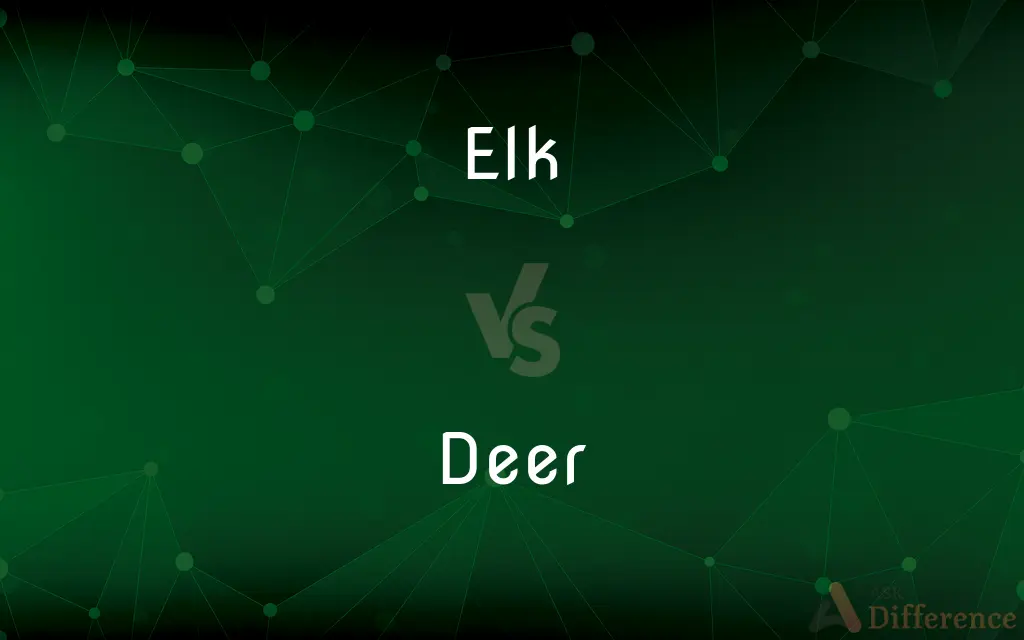Elk vs. Deer — What's the Difference?
Edited by Tayyaba Rehman — By Fiza Rafique — Updated on September 26, 2023
Elk is a large species of deer with large antlers found in North America and Eastern Asia. Deer is a ruminant mammal with cloven hoofs and typically with antlers borne by males.

Difference Between Elk and Deer
Table of Contents
ADVERTISEMENT
Key Differences
Elk and Deer are both members of the Cervidae family, but they are distinct species with noticeable differences. The Elk, also known as wapiti, is a larger species compared to most deer.
In North America, when one mentions Elk, they are referring to a specific large species, whereas the term Deer is more generic and can refer to many species, including the white-tailed deer, mule deer, and others.
Culinary enthusiasts might note that both Elk and Deer are sources of venison. However, due to their size difference, Elk yields more meat than the average Deer, and some claim a different taste profile between the two.
Comparison Chart
Size
Larger
Generally smaller
Mane
Darker and shaggier mane
Lacks a thick mane
ADVERTISEMENT
Geographical Spread
North America and Eastern Asia
Worldwide
Typical Habitat
Mountainous terrains/dense brush
Forests, meadows, and plains
Yield of Meat
Provides more meat
Provides less meat
Compare with Definitions
Elk
Also known as wapiti, distinct from other deer species.
Many tourists hope to spot an Elk when visiting national parks.
Deer
Another source of venison, often hunted or raised for meat.
He prepared a delicious Deer stew for dinner.
Elk
A herbivorous mammal with large antlers typically carried by males.
The male Elk stood guard, displaying his impressive antlers.
Deer
A ruminant mammal with cloven hoofs, usually with antlers in males.
The Deer grazed peacefully in the meadow.
Elk
Possesses a distinctive shaggy mane around its neck.
The Elk's mane set it apart from the other animals.
Deer
A herbivore known for its agility and grace.
The Deer bounded away at the sound of footsteps.
Elk
A large species of deer found primarily in North America and Eastern Asia.
The Elk's bugling echoed through the mountains.
Deer
A popular subject in folklore and cultural narratives.
The legend speaks of a golden Deer leading the way.
Elk
The elk (Cervus canadensis), also known as the wapiti, is one of the largest species within the deer family, Cervidae, and one of the largest terrestrial mammals in North America, as well as Central and East Asia. It is often confused with the larger Alces alces, which is called moose in North America, but called elk in British English, and related names in other European languages (German Elch, Swedish älg, French élan).
Deer
Represents a wide range of species, including white-tailed deer and mule deer.
The Deer in our backyard was a white-tailed one.
Elk
A large reddish-brown or grayish deer (Cervus canadensis) of western North America, having long, branching antlers in the male. The elk is sometimes considered a subspecies of the closely related red deer. Also called wapiti.
Deer
Deer or true deer are hoofed ruminant mammals forming the family Cervidae. The two main groups of deer are the Cervinae, including the muntjac, the elk (wapiti), the red deer, the fallow deer, and the chital; and the Capreolinae, including the reindeer (caribou), the roe deer, the mule deer, and the moose.
Elk
Chiefly British The moose.
Deer
Any of various hoofed ruminant mammals of the family Cervidae, characteristically having deciduous antlers borne chiefly by the males. The deer family includes the white-tailed deer, elk, moose, and caribou.
Elk
A light, pliant leather of horsehide or calfskin, tanned and finished to resemble elk hide.
Deer
A ruminant mammal with antlers and hooves of the family Cervidae, or one of several similar animals from related families of the order Artiodactyla.
Elk
Any of various large species of deer such as the red deer, moose or wapiti (see usage notes).
Deer
(in particular) One of the smaller animals of this family, distinguished from a moose or elk
I wrecked my car after a deer ran across the road.
Elk
Any of the subspecies of the moose (Alces alces, alternatively named Eurasian elk to avoid confusion with the wapiti), that occurs only in Europe and Asia.
Deer
The meat of such an animal; venison.
Oh, I've never had deer before.
Elk
Any moose (Alces alces), the largest member of the deer family.
Deer
Any animal, especially a quadrupedal mammal as opposed to a bird, fish, etc.
Elk
(North America) common wapiti (Cervus canadensis), the second largest member of the deer family, once thought to be a subspecies of red deer.
Deer
Any animal; especially, a wild animal.
Mice and rats, and such small deer.
The camel, that great deer.
Elk
(British India) Sambar (Cervus unicolor).
Deer
A ruminant of the genus Cervus, of many species, and of related genera of the family Cervidæ. The males, and in some species the females, have solid antlers, often much branched, which are shed annually. Their flesh, for which they are hunted, is called venison.
Elk
A large deer, of several species. The European elk Alces alces (formerly Alces machlis or Cervus alces) is closely allied to the American moose. The American elk, or wapiti (Cervus Canadensis) the largest member of the deer family, has large, spreading antlers and is closely related to the European stag. See Moose, and Wapiti.
Deer
Distinguished from Bovidae by the male's having solid deciduous antlers
Elk
The European wild or whistling swan (Cygnus ferus).
Elk
A member of the fraternal organization named Benevolent and Protective Order of Elks, supporting various services to their communities.
Elk
Large northern deer with enormous flattened antlers in the male; called elk in Europe and moose in North America
Elk
A source of venison in culinary dishes.
The restaurant's menu featured roasted Elk.
Common Curiosities
How do Elk differ from Deer?
Elk are larger with a shaggier mane and represent a specific species, whereas "Deer" covers multiple species.
Do only male Elk have antlers?
Yes, typically only male Elk have large antlers.
What is an Elk?
An Elk, or wapiti, is a large species of deer found in North America and Eastern Asia.
Do Deer have a mane like the Elk?
Most deer species lack the thick, shaggy mane characteristic of Elk.
Can Elk be found in urban or suburban areas?
Generally, Elk prefer mountainous or densely brushed areas, unlike some deer which venture into suburban areas.
Do both Elk and Deer shed their antlers?
Yes, male Elk and most male Deer species shed and regrow their antlers annually.
What do Elk eat?
Elk are herbivores, grazing on grass, plants, and leaves.
Is the term 'Deer' specific to one species?
No, "Deer" is a general term that includes multiple species, such as white-tailed deer, mule deer, and more.
Are Deer found only in North America?
No, Deer species are found worldwide.
Are Elk found worldwide?
No, Elk are primarily found in North America and Eastern Asia.
Which is larger, an Elk or a Deer?
Typically, an Elk is larger than most deer species.
What's the significance of Elk's bugling?
Bugling is a vocalization primarily by male Elk during the rutting season, attracting females and challenging rival males.
Is venison only from Deer?
No, venison can refer to the meat of both Elk and Deer.
Which provides more meat, an Elk or a Deer?
Due to its larger size, an Elk generally provides more meat than a Deer.
Which is more commonly seen in populated areas?
Deer, especially species like the white-tailed deer, are more commonly seen near populated areas compared to Elk.
Share Your Discovery

Previous Comparison
Ream vs. Rim
Next Comparison
Hear vs. ListenAuthor Spotlight
Written by
Fiza RafiqueFiza Rafique is a skilled content writer at AskDifference.com, where she meticulously refines and enhances written pieces. Drawing from her vast editorial expertise, Fiza ensures clarity, accuracy, and precision in every article. Passionate about language, she continually seeks to elevate the quality of content for readers worldwide.
Edited by
Tayyaba RehmanTayyaba Rehman is a distinguished writer, currently serving as a primary contributor to askdifference.com. As a researcher in semantics and etymology, Tayyaba's passion for the complexity of languages and their distinctions has found a perfect home on the platform. Tayyaba delves into the intricacies of language, distinguishing between commonly confused words and phrases, thereby providing clarity for readers worldwide.














































